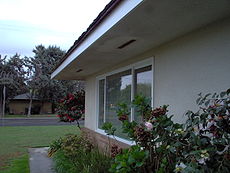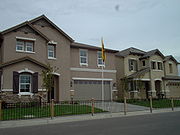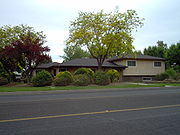
Ranch-style house
Encyclopedia



Architectural style
Architectural styles classify architecture in terms of the use of form, techniques, materials, time period, region and other stylistic influences. It overlaps with, and emerges from the study of the evolution and history of architecture...
originating in the United States
United States
The United States of America is a federal constitutional republic comprising fifty states and a federal district...
. First built in the 1920s, the ranch style was extremely popular amongst the booming post-war middle class of the 1940s to 1970s. The style was exported to other nations and so is found in other countries.
The style is often associated with tract housing
Tract housing
Tract housing is a style of housing development in which multiple similar homes are built on a tract of land which is subdivided into individual small lots...
built during this period, particularly in the western United States, which experienced a population explosion during this period, with a corresponding demand for housing.
The ranch house is noted for its long, close-to-the-ground profile, and minimal use of exterior and interior decoration. The houses fuse modernist ideas and styles with notions of the American Western period working ranches to create a very informal and casual living style. Their popularity waned in the late 20th century as neo-eclectic house styles, a return to using historical and traditional decoration, became popular. However, in recent years, interest in ranch house designs has been increasing.
Preservationist movements have begun in some ranch house neighborhoods, as well as renewed interest in the style from a younger generation who did not grow up in ranch-style houses. This renewed interest in the ranch house style has been compared to that which other house styles such as the bungalow
Bungalow
A bungalow is a type of house, with varying meanings across the world. Common features to many of these definitions include being detached, low-rise , and the use of verandahs...
and Queen Anne
Queen Anne Style architecture
The Queen Anne Style in Britain means either the English Baroque architectural style roughly of the reign of Queen Anne , or a revived form that was popular in the last quarter of the 19th century and the early decades of the 20th century...
experienced in the 20th century, initial dominance of the market, replacement as the desired housing style, decay and disinterest coupled with many teardowns, then renewed interest and gentrification of the surviving homes.
Features

- Single story
- Long, low roofline
- Asymmetrical rectangular, L-shaped, or U-shaped design
- Simple, open floor planFloor planIn architecture and building engineering, a floor plan, or floorplan, is a diagram, usually to scale, showing a view from above of the relationships between rooms, spaces and other physical features at one level of a structure....
s - Small, working kitchens
- Minimal closets in the bedroom(s)
- Living areas separate from the bedroom(s) area
- Attached garage
- Sliding glass doors opening onto a patio
- Large windows, often decorated with shutters
- Vaulted ceilings with exposed beams
- Exteriors of stucco, brick and wood
- Large overhanging eaves
- Cross-gabled, side-gabled or hip roofHip roofA hip roof, or hipped roof, is a type of roof where all sides slope downwards to the walls, usually with a fairly gentle slope. Thus it is a house with no gables or other vertical sides to the roof. A square hip roof is shaped like a pyramid. Hip roofs on the houses could have two triangular side...
- Simple and/or rustic interior and exterior trim
History and development
The 20th century ranch house style has its roots in North American Spanish colonial architecture of the 17th to 19th century. These buildings used single storey floor plans and native materials in a simple style to meet the needs of their inhabitants. Walls were often built of adobe brick and covered with plaster, or more simply used board and batten wood siding. Roofs were low and simple, and usually had wide eaves to help shade the windows from the Southwestern heat. Buildings often had interior courtyards which were surrounded by a U shaped floor plan. Large front porches were also common. These low slung, thick walled, rustic working ranches were common in the Southwestern states.Era of popularity
By the 1950s, the California ranch house, by now often called simply the ranch house or even "rambler house", accounted for nine out of every ten new houses. The seemingly endless ability of the style to accommodate the individual needs of the owner/occupant, combined with the very modern inclusion of the latest in building developments and simplicity of the design satisfied the needs of the time. Ranch houses were built throughout America and were often given regional facelifts to suit regional tastes. The "Colonial Ranch" of the Midwest and East Coast is one such noted variant, adding American Colonial features to the facade of the California ranch house. Ranch homes of the 1940s and 1950s are typically more deliberately rustic in nature than those of the 1960s and 1970s, with features such as dovecotes, Swiss board edging on trim, and generally western and even fantasy trim styling. In the 1960s, the ranch house echoed the national trend towards sleekness in design, with the homes becoming even simpler in trim and ornamentation.Decline

Googie architecture
Googie architecture is a form of modern architecture, a subdivision of futurist architecture influenced by car culture and the Space and Atomic Ages....
and Modernism
Modernism
Modernism, in its broadest definition, is modern thought, character, or practice. More specifically, the term describes the modernist movement, its set of cultural tendencies and array of associated cultural movements, originally arising from wide-scale and far-reaching changes to Western society...
and ranch homes towards more formal and traditional styles. Builders of ranch houses also began to simplify and cheapen construction of the homes to cut costs, eventually reducing the style down to a very bland and uninteresting house, with little of the charm and drama of the early versions. By the late 1970s, the ranch house was no longer the home of choice, and had been eclipsed by the neo-eclectic styles of the late 20th century. Very late custom ranch homes of the later 1970s begin to exhibit features of the neo-eclectics, such as dramatically elevated rooflines, grand entryways, and traditional detailing. These neo-eclectic homes typically continue many of the lifestyle interior features of the ranch house, such as open floor plans, attached garages, eat-in kitchens, and built-in patios, though their exterior styling typically owes more to northern Europe or Italy or 18th and 19th century homes styles than the ranch house. Neo-eclectic houses also have a significant level of formality in their design, both externally and internally, the exact opposite of the typical ranch style house. Additionally, the increase in land prices has meant a corresponding increase in the number of two storey homes being built, and a shrinking of the size of the average lot; both trends inhibit the traditional ranch house style. Ranch style houses are occasionally still built today, but mainly in the Western states and, usually, as individual custom homes.
Revival of interest
Beginning in the late 1990s, a revival of interest in the ranch style house occurred in United States. The renewed interest in the design is mainly focused on existing homes and neighbourhoods, not new construction. Younger house buyers find that ranch houses are affordable entry level homes in many markets, and the single story living of the house attracts older buyers looking for a house they can navigate easily as they age. The houses' uniquely American heritage, being an indigenous design, has furthered interest as well. The houses' simplicity and unpretentious nature, in marked contrast to the more dramatic and formal nature of neo-eclectic houses, makes them appealing for some buyers. The more distinctive ranch houses, such as modernist Eichlers or Cliff May designs, as well as custom homes with a full complement of the style's features, are in particular demand in many markets. Many neighborhoods featuring ranch-style houses are now well-established, with large trees and often with owner modifications that give these sometimes repetitive styles individual character. As these homes were mainly built in the time frame of 1945 to 1970, they are modern in their infrastructure; their heating/cooling systems, wiring, plumbing, windows, doors, and other systems can all be easily repaired and upgraded.Revival of the ranch-style house
Small scale tract building of ranch houses ended in the late 1970s and early 1980s. Those still built today have usually been individual custom homes. One known exception is a tract of ranch-style homes briefly built in California in 2007/08. These houses borrowed their style cues from the 1950s Western styled ranch houses, with board and batten siding, dovecotes, large eaves, and extensive porches. Notably, all homes in this tract were on 1/4 acre lots, and have their front garages turned sideways so that the garage doors were not dominating the front of the house.Variations
Two-story versions

Foundation (architecture)
A foundation is the lowest and supporting layer of a structure. Foundations are generally divided into two categories: shallow foundations and deep foundations.-Shallow foundations:...
serves as an additional floor, often called a split level, a modification of the dominant one story design. The common result is a two-story
Floor
A floor is the walking surface of a room or vehicle. Floors vary from simple dirt in a cave to many-layered surfaces using modern technology...
version of a ranch-style house. It may be built into a hill to some degree, such that the full size of the house is not evident from the curb.
"Commercial versions"
The ranch house style was adapted for commercial use during the time of the style's popularity. As the concept of a "drive in" shopping center was being created and popularized, the ranch style was a perfect style to fit into the large tracts of ranch homes being built. Commercial ranch buildings, such as supermarkets and strip malls, typically follow the residential style with simple rustic trim, stucco or board and batten siding, exposed brick and shake roofs, and large windows.
Criticisms
Ranch style houses have been subject to criticism almost from their inception. General criticisms are that ranch style houses lack a style and are too sterile and utilitarian. Their sheer commonness often makes them a target of disdain.See also
- Split level homeSplit level homeA split-level home is a style of house in which the floor level of one part of the house is about half way between the floor and ceiling of the other part of the house. The one story section typically contains a family room, living room, dining room, and kitchen...
s - Cliff MayCliff MayCliff May was an architect practicing in California best known and remembered for developing the suburban Post-war "dream home" — the California Ranch House.-Projects and the Ranch-style house:...
- American craftsmanAmerican CraftsmanThe American Craftsman Style, or the American Arts and Crafts Movement, is an American domestic architectural, interior design, landscape design, applied arts, and decorative arts style and lifestyle philosophy that began in the last years of the 19th century. As a comprehensive design and art...
- Mission Revival Style architectureMission Revival Style architectureThe Mission Revival Style was an architectural movement that began in the late 19th century for a colonial style's revivalism and reinterpretation, which drew inspiration from the late 18th and early 19th century Spanish missions in California....
- BungalowBungalowA bungalow is a type of house, with varying meanings across the world. Common features to many of these definitions include being detached, low-rise , and the use of verandahs...
- Mar del Plata styleMar del Plata styleThe Mar del Plata style is a domestic architectural style very popular during the decades between 1935 and 1950 mainly in the Argentine resort city of Mar del Plata, but extended to other coastal towns like Miramar and Necochea.-Origins:...
Further reading
- Gregory, Daniel P., (2008) Cliff May and the Modern Ranch House, New York, Rizzoli, ISBN=139780847830473
- Samon, Katherine Ann (2003). Ranch House Style. New York: Clarkson Potter. ISBN 0-609-60628-X.
External links
- About Ranch Style Houses
- Atomic Ranch Magazine
- 1951 Ranch Redo
- Once and Future Ranch
- Ranch Revival
- How America fell in and out of love with the ranch house
- The Ranch House Lives On•
- Restoring the Ranch Burger
- A tract of Ranch Homes currently being built in California
- Six New Ranch House-Inspired Plans
- The Ranch House in Georgia, Guidelines for Evaluation

